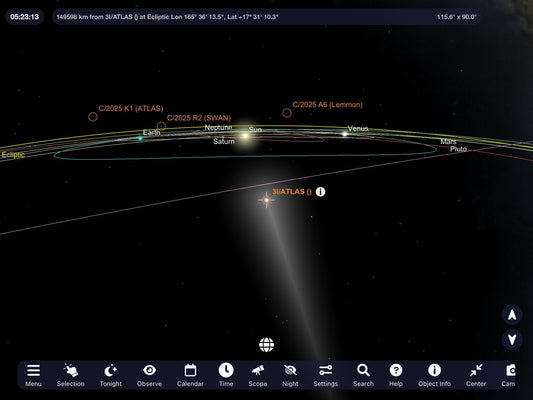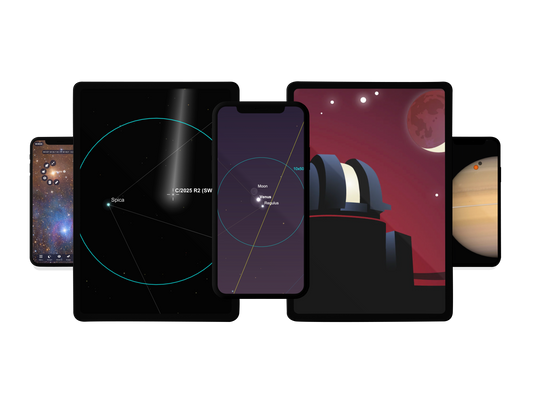StarSense Explorer Technology
Powered by SkySafari 6 Pro Technology!
StarSense Explorer’s sky recognition technology has revolutionized the manual telescope by eliminating the confusion common among beginners and enhancing the user experience for even seasoned telescope users.
Many would-be astronomers become frustrated or lose interest in their manual (i.e. non-computerized) telescope because they don’t where to point it to see planets, star clusters, nebulae, and galaxies—the good stuff!
StarSense Explorer tells you exactly which celestial objects are currently visible in the night sky and where to move your telescope to place those objects in the telescope’s eyepiece. What’s more, you can access detailed information and even audio descriptions for the most popular objects while you observe. No prior knowledge of the night sky is required.
At the heart of the system is StarSense Explorer’s sky recognition and sky mapping capability. The StarSense Explorer uses your smartphone to very accurately determine its pointing position by “plate solving.”

The StarSense Dock
The StarSense dock—a special bracket that couples the smartphone to the StarSense Explorer telescope—holds the smartphone in place over an integrated mirror. The star patterns overhead reflect off the mirror and into the smartphone’s camera. The mirror is tilted slightly relative to the telescope to provide better performance when locating objects low in the sky.
The dock holds most smartphones with their cases attached. It’s equipped with X-Y adjustment knobs to help you position the camera over the mirror. The dock also features a built-in shade around the mirror to prevent stray light from entering the smartphone camera’s field of view.

The Celestron StarSense Explorer App
The StarSense Explorer app runs on a user-supplied smartphone attached to the StarSense Explorer telescope via the StarSense dock. When you launch the app, it guides you through a simple two-step procedure to align the smartphone’s camera with the telescope’s field of view.
Next, the app displays a view of the night sky and shows a bullseye on the screen to represent the telescope’s current pointing position. From here, you can select an object to view, either by tapping it in the planetarium view or selecting it from the Tonight’s Best observing list. Objects that are highlighted in the planetarium view or listed as Tonight’s Best list are our recommended targets—all currently visible above the horizon from your observing site. You’ll see a variety of objects, which will vary from night to night. You may see planets like Jupiter or Saturn, nebulae like Orion, the Andromeda Galaxy, or other object types.
Once you select an object, the app displays pointing arrows onscreen. These indicate the direction in which you should move the telescope to find the object. Move the telescope as directed until the bullseye appears centered on the selected object onscreen. When the bullseye changes its color to green, the object is visible in the telescope’s lower powered eyepiece.
You can observe the object while listening to an audio presentation or you can peruse other object information and data within the app. There are even observing tips to help get the best view possible though the telescope for the selected object.

How it Works: Plate Solving
StarSense Explorer uses image data captured by the smartphone’s camera to determine its pointing position. The app captures an image of the night sky and then matches the star patterns within the image to its internal database in a process similar to fingerprint matching or facial recognition.
Essentially, StarSense Explorer uses the smartphone’s camera as its “eye” and the smartphone’s processing power as its “brain.” The camera looks out at the night sky, and then the processor figures out where the telescope is pointing based upon the calculated center coordinates of the captured image.
The process of extracting star pattern data in images to determine a telescope’s current pointing position is called “plate solving.” It is the same method used by professional observatories and even orbiting satellites.

SHOP STARSENSE EXPLORER >
The StarSense Explorer app is the first app ever developed that uses plate solving to determine the smartphone’s current pointing position. The app provides a typical pointing accuracy of about 0.25°.
Other astronomy apps do not use plate solving. Instead, they rely exclusively on the smartphone’s internal gyroscopes, accelerometers, and compass to estimate the smartphone’s pointing position. When coupled to a manual telescope, the resultant pointing is not accurate enough to place astronomical objects within the telescope’s field of view.
The typical low-power field of view for a telescope is about 1°, and the pointing accuracy of a smartphone using only its internal sensors is a few degrees at best. So, even when the smartphone thinks it is pointed at the object, it will be pointed a several degrees away, and won’t appear in the telescope’s eyepiece. This prevents all other astronomy apps from using the smartphone for accurate telescope pointing.
StarSense Explorer vs. Computerized Telescopes
StarSense Explorer technology brings the benefit of computerized telescope pointing to manual telescopes without expensive motors, encoders, hand controllers, or integrated electronics.
Computerized telescopes typically require an alignment process with the night sky. Although Celestron has simplified the alignment procedure over the years, it still requires the user to center the telescope on several stars before it can accurately find objects. What’s more, re-alignment may be needed if the mount is bumped or otherwise moved.
StarSense Explorer telescopes require no alignment to the night sky because they automatically (and quickly) plate solve each time the phone is repositioned. Therefore, StarSense Explorer telescopes can be picked up and moved to a different observing location without any need for realignment.
StarSense Explorer technology is a huge breakthrough for amateur astronomers. It uses a smartphone as a self-contained plate solving system: it captures the images, processes the images, extracts the star pattern data, and determines the center coordinates of the image all by itself.
A typical system able to plate solve would require several pieces or expensive equipment, such as a sensitive imaging camera, camera lens, external computer, and specialized astronomical software. Using a smartphone to independently do astronomical plate solving is a significant step forward in the progression of amateur astronomy and astronomy apps. StarSense Explorer technology transforms your smartphone into the perfect telescope observing assistant. In doing so, it allows StarSense Explorer telescopes to provide an upgraded astronomical observing experience without the cost associated with more expensive computerized systems.
StarSense Explorer technology is patent-pending.
Smartphone Compatibility
The StarSense Explorer app runs on the iOS and Android platforms. It is compatible with iPhone 6 and higher, and most smartphones running Android 7.1.2 and higher. For a complete compatibility list, click here.
It is distributed through the Apple Store and Google Play. The app is available as a free download but does not unlock its telescope pointing functionality until an unlock code is entered. The unlock code is provided only with StarSense Explorer telescopes.
Blog posts
View all-

The Best Holiday Telescope: Celestron StarSense...
If you are searching for a gift that inspires curiosity and keeps giving long after the wrapping paper is gone, the Celestron StarSense Explorer DX 5" powered by SkySafari is...
The Best Holiday Telescope: Celestron StarSense...
If you are searching for a gift that inspires curiosity and keeps giving long after the wrapping paper is gone, the Celestron StarSense Explorer DX 5" powered by SkySafari is...
-

Comet Chaos: A SkySafari Spectacle
October 2025 brings Comet Chaos, a cosmic carnival of three dazzling wanderers streaking through the heavens.
7 commentsComet Chaos: A SkySafari Spectacle
October 2025 brings Comet Chaos, a cosmic carnival of three dazzling wanderers streaking through the heavens.
7 comments -

Celestial Highlights You Won’t Want to Miss
The cosmos is serving up a feast of wonders this season, each a reminder to keep your eyes on the skies and SkySafari close at hand.
4 commentsCelestial Highlights You Won’t Want to Miss
The cosmos is serving up a feast of wonders this season, each a reminder to keep your eyes on the skies and SkySafari close at hand.
4 comments





